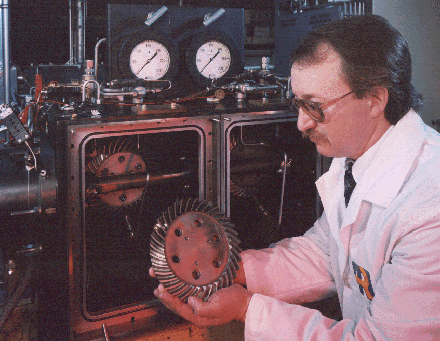 |
|||||
| Home | Research | For Teachers | HISTORY Level 1 Level 2 Level 3 |
PRINCIPLES Level 1 Level 2 Level 3 |
CAREER Level 1 Level 2 Level 3 |
| Gallery | Hot Links | What's New! | |||
| Web Administration and Tools | |||||
 |
|||||
| Home | Research | For Teachers | HISTORY Level 1 Level 2 Level 3 |
PRINCIPLES Level 1 Level 2 Level 3 |
CAREER Level 1 Level 2 Level 3 |
| Gallery | Hot Links | What's New! | |||
| Web Administration and Tools | |||||
![]()
Basic programs address the needs of both the Army and NASA Lewis by concentrating on advancing gear technology for a wide variety of uses that require in-depth knowledge and precision. Program goals are to increase life, reliability, and maintainability; reduce weight, noise and vibration; and maintain high mechanical efficiency of drive trains. Emphasis is on aeronautical applications - in particular, helicopter transmissions.
All aspects of analytical and experimental research are pursued, including disciplines related to details of gear-tooth shapes and types of geometries, materials, thermal behavior, lubrication, noise and vibration, and manufacturing methods. The analytical portion is accomplished through both in-house and university grant efforts. The computer codes developed as a result of the analytical research are distributed to industry for their use in gear analysis and design. As an important part of the process, NASA Lewis has provided unique facilities for this experimental research. Spur and bevel gear component test rigs are used to conduct fatigue testing, evaluate candidate materials, compare lubricants and to evaluate and develop vibration diagnostics techniques. A high-speed gear rig is available to study meshes that operate at very high pitchline velocities. A split torque rig is used to test multiple power path gear arrangements. An important feature of these test facilities is their use in verifying the codes developed in the analytical research.
POC: Dr. Robert F. Handschuh

Spiral Bevel Gear Rig
![]()
Send all comments to ![]() aeromaster@eng.fiu.edu
aeromaster@eng.fiu.edu
© 1995-98 ALLSTAR Network. All rights reserved worldwide.
Updated: February 17, 1999